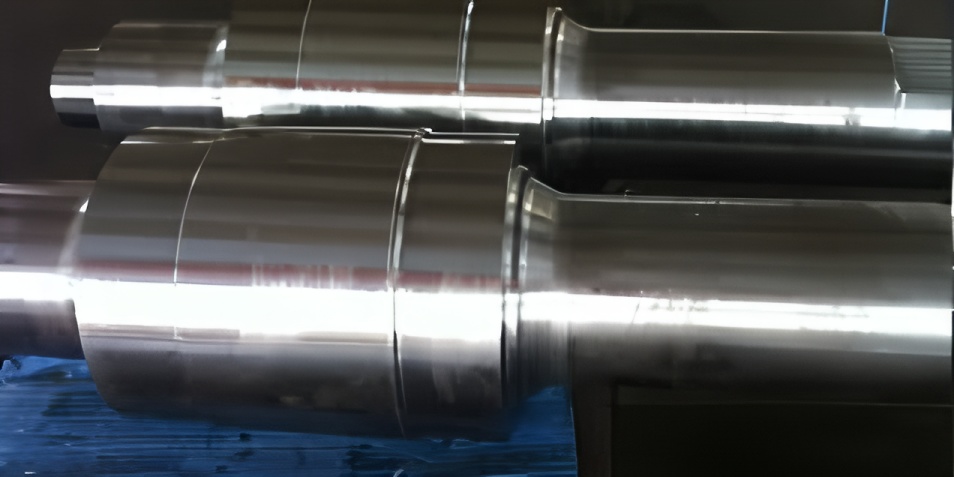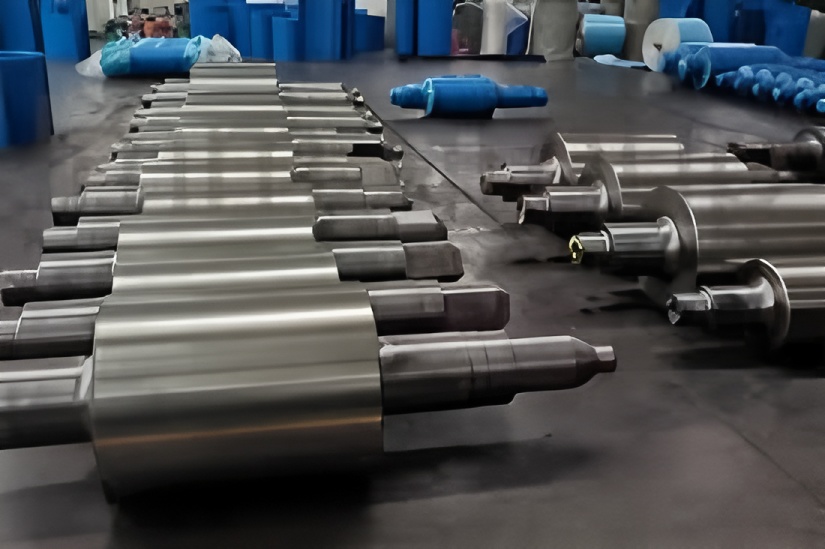Roll Classifications and Material Selection: A Comprehensive Guide
This article outlines the classification of rolls and the selection criteria for roll materials.
Keywords: roll; classification; material
Classification of Rolls
Cast Iron Roll
Cast iron rolls typically have a carbon content of approximately 2.5% to 3.5%. Based on their primary material composition, they can be categorized into four types: ordinary cast iron rolls, high-nickel-chromium indefinite chilled composite cast iron rolls, high-chromium composite cast iron rolls, and alloy nodular cast iron rolls. Common structural constituents of cast iron rolls include the matrix, cementite, and graphite. The matrix may consist of tensite, ferrite, pearlite, bainite, or martensite. Graphite in cast iron generally appears in flake or spheroidal form.
Ordinary Cast Iron Roll
These can be further classified into chilled cast iron rolls, medium/low alloy indefinite chilled cast iron rolls, and medium/low alloy nodular iron rolls. Chilled cast iron is produced through the self-undercooling of molten iron and surface quenching via the mold, forming a white layer on the roller body surface that offers high hardness and wear resistance. Based on the manufacturing process and core material, chilled cast iron rolls are divided into non-nodular iron, nodular composite, and spheroidal core types. Indefinite chilled cast iron offers a transitional material between chilled cast iron and gray iron, with graphite present in the roll body’s working layer and no clear boundary between the working layer and the core. Such rolls are considered lower-end products and are mainly used in cluster plate mills, three-high Lauth mills, wire rod mills, bar mills, and structural mills.
High Nickel Chromium Indefinite Chilled Composite Iron Roll
This material falls between chilled iron and gray iron. The working layer contains uniformly distributed graphite, with graphite content and hardness gradually decreasing from the surface inward. Hence, there is no distinct boundary between the working layer and the core, earning it the name “unbounded chilled cast iron roll.” Alloying elements such as high chromium, nickel, and molybdenum are incorporated, and these rolls are produced via full flush (overflow) or centrifugal composite casting.
The matrix contains numerous carbides, providing high wear resistance, while the presence of graphite offers good heat resistance. These rolls are widely used as finishing rolls in wide, medium, and heavy plate mills and strip mills.
High Chromium Composite Cast Iron Roll
These are produced using high-chromium white wear-resistant cast iron (12–22% Cr) as the outer layer, with nodular iron typically used for the core and neck. Manufactured via centrifugal composite casting, these high-alloy composite cast iron rolls contain lath-like Cr₇C₃ eutectic carbides, chrysanthemum-like Mo₂C eutectic carbides, and granular Cr₂₃C₆ secondary carbides in the matrix, providing excellent wear resistance. They are commonly applied in roughing and pre-finishing work rolls for hot-rolled strip tandem mills, roughing and finishing work rolls for wide/medium plate mills, and finishing rolls for small section and plate mills.
Alloy Nodular Iron Roll
These rolls offer high tensile strength, capacity for heavy loads, and good wear resistance due to uniformly distributed graphite from the body to the core. The matrix consists of carbides and pearlite or acicular ferrite. Based on the matrix structure, they are categorized as pearlitic or acicular nodular iron rolls. While usually cast as a whole, the centrifugal composite process may be used for high-alloy acicular iron rolls to achieve optimal comprehensive properties. These rolls exhibit good thermal shock and wear resistance, making them suitable for use in large blooming mills, section mills, continuous bar mills, and large seamless tube mills.
Cast Steel Roll
Cast steel rolls fall into two categories: steel rolls (C: 0.4–1.4%) and semi-steel rolls (C: 1.4–2.4%). Steel rolls have lower carbon content and thus lower hardness, with a structure of ferrite and pearlite. Increasing carbon content reduces ferrite and increases pearlite. Alloying elements like Cr, Ni, and Mo can be added, or special heat treatments applied, to enhance hardness. Given their high tensile strength and toughness, steel rolls suit high-temperature, heavy-load rolling conditions such as billet or blooming mills, and can also serve as backup rolls. With special heat treatment achieving hardness above HS90, they may also be used as cold work rolls.
Semi-steel rolls have a carbon content between cast steel and cast iron. Their structure is mainly pearlitic with some carbides, offering slightly higher strength than cast steel but lower than cast iron. A key feature is their minimal internal hardness drop, making them ideal for deep-groove rolls and early-stage roughing and finishing work rolls. Adding silicon and applying graphitization can enhance thermal crack resistance and toughness, making them suitable for vertical rolls.
Alloy Cast Steel Roll
Depending on chemical composition and heat treatment, the matrix can be pearlitic (flake or spheroidized) or bainitic. Tempered sorbitic structures provide high strength, toughness, and exceptional thermal cracking resistance, especially those with secondary phases, offering excellent wear resistance for roughing applications.
These rolls possess high tensile strength, toughness, moderate wear and thermal crack resistance, and are mainly used for blooming mill breakdown rolls and section mill roughing rolls.
Cast High Chromium Steel Roll
These are produced using high-chromium steel (C: 0.5–1.5%, Cr: 8–15%) as the outer layer and nodular iron for the core via centrifugal composite casting. The outer layer has a chromium-rich matrix structure offering superior wear resistance over high-chromium cast iron. With lower carbide content, it also exhibits excellent thermal cracking resistance, making it a current trend for roughing rolls in hot continuous rolling mills.
Centrifugal Composite High-Speed Steel Roll
High-speed steel rolls provide high thermal cracking resistance, wear resistance, and red hardness, significantly extending service life and improving rolled product quality.

Semi-Steel Roll
With carbon content usually between 1.4% and 2.4%, semi-steel offers mechanical properties介于铸钢和铸铁之间. When carbon exceeds 1.9%, it is termed high-carbon semi-steel, which contains eutectic and pseudo-eutectic carbides in the matrix. Used in continuous billet mill stands, intermediate and finishing stands of section mills. Adding silicon enhances crack resistance, resulting in graphitic cast steel rolls that combine cast steel and cast iron advantages, widely used in hot billet and section mills.
Forged Steel Series Roll
Through smelting, forging, and heat treatment, forged steel rolls achieve a uniform, high-hardness working layer with excellent wear and accident resistance, while the neck and core maintain high strength and toughness. This unique performance makes them irreplaceable in cold and non-ferrous rolling. Forged steel rolls include hot rolls (for hot billet and section roughing) and cold rolls (for cold rolling applications). Cold rolls require high, uniform surface hardness to ensure dimensional accuracy and surface quality of strips or plates, a sufficient hardened depth, and high accident resistance. This demands strict metallurgical quality and structural uniformity. Current common cold roll materials in China contain about 2% Cr, with an effective hardened layer (≥HS90) of about 10 mm. Newly developed Cr5 series rolls (5% Cr) offer an effective hardened layer exceeding 30 mm. The superior performance of Cr5 series work rolls is gradually replacing traditional C2 series rolls, representing the future direction for cold rolling work rolls.
Selection of Roll Material
Selection of Work Roll Material
Roughing initial stands (R1): Rolls must possess strength, toughness, wear resistance, and thermal crack resistance, with hardness around HS40–55. Materials such as 60CrNiMo cast steel are typically used.
Roughing later stands (R2): Require good thermal cracking resistance. Materials include semi-steel, high-chromium steel, and high-speed steel.
Finishing initial stands (F1–F4): High temperature and heavy load conditions. Common materials are cast semi-steel and high-chromium centrifugal cast iron, which provide high wear resistance, thermal crack resistance, and reduce surface spotting defects.
Finishing later stands (F5–F7): Critical for product quality and surface finish, requiring high hardness, wear resistance, indentation resistance, spalling resistance, and thermal crack resistance. Typically made from indefinite chilled cast iron (standard or improved grades).
Material Selection for Backup Rolls and Vertical Rolls
Requirements align with those outlined above for work rolls in corresponding positions, focusing on strength, thermal resistance, and wear properties as appropriate for the specific mill stand and rolling operation.


